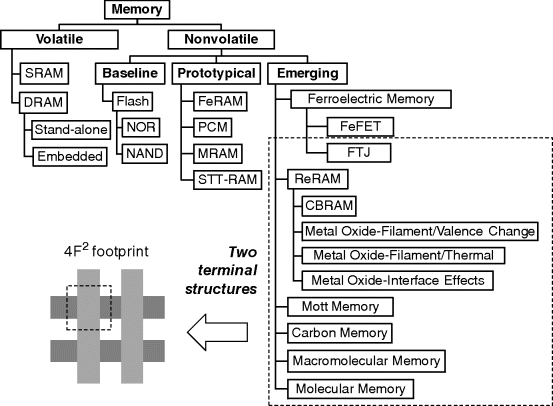12Memory Select Devices
An Chen
GLOBALFOUNDRIES Inc., USA
12.1 Introduction
With Flash memories approaching the scaling limit, some novel memory devices have emerged as potential candidates for Flash memory replacement, as shown in the taxonomy in Figure 12.1 [1]. Some promising examples include phase change memory (PCM), resistive random access memory (RRAM), spin transfer torque random access memory (STTRAM), and so on.

Figure 12.1 Memory taxonomy with two-terminal emerging memory devices highlighted. Inset shows a crossbar array layout with 4F2 device footprint
Many emerging nonvolatile memories (NVMs) have a simple two-terminal structure compatible with crossbar array architecture. Crossbar array layout enables device footprint as small as 4F2 (F: critical dimension of a technology node). By stacking up multiple layers of crossbar arrays [2,3] or building vertical 3D memory structures [4,5], even smaller footprint and higher memory density can be achieved. On the other hand, crossbar memory arrays also face challenges in device selection and isolation, which needs to be addressed by functional memory select devices.
12.2 Crossbar Array and Memory Select Devices
In crossbar arrays, memory devices are built at the junction between horizontal wordlines (WLs) and vertical bitlines (BLs), as shown in Figure 12.2. A device (e.g., Rj) is selected by applying voltages to its ...
Get Emerging Nanoelectronic Devices now with the O’Reilly learning platform.
O’Reilly members experience books, live events, courses curated by job role, and more from O’Reilly and nearly 200 top publishers.

